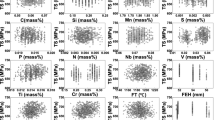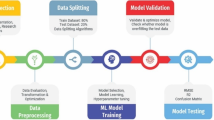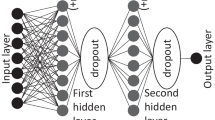Abstract
This paper develops a regression based and neural network machine learning (ML) model for the prediction of mechanical properties of wire arc additively manufactured (WAAMed) steel. The presented data driven approach studies the correlation between input parameters and ensuing mechanical properties to increase the competency in terms of efficiency and result optimality. In this work, the interaction of various process parameters i.e. current, voltage, wire feed speed, travel speed and gas flow rate on arriving the mechanical properties (YS and UTS) in different orientations is investigated. The model utilizes 137 experimental datasets for machine learning models. The developed machine learning models were validated through inhouse experimentation. Quantitative results suggested that the both models predicted the mechanical properties with good accuracy, but the random forest model outperform the neural network model in term of percentage error values. The occurrence of inhomogeneity in the microstructure and mechanical properties of the as-built wall is investigated. The microstructure of 316L thin wall consists of ferrite and austenite as main constituent phases, and ferrite morphology and presence of σ-phase inclusion have an impact on hardness and mechanical properties. The average hardness, YS and UTS values are 185 Hv0.2, 303 ± 6 MPa and 490 ± 18 MPa respectively.






Similar content being viewed by others
References
K.S. Derekar, A Review of Wire Arc Additive Manufacturing and Advances in Wire Arc Additive Manufacturing of Aluminium, Mater. Sci. Technol. (United Kingdom), 2018, 34(8), p 895–916. https://doi.org/10.1080/02670836.2018.1455012
S. Thapliyal, Challenges Associated with the Wire Arc Additive Manufacturing (WAAM) of Aluminum Alloys, Mater. Res. Exp., 2019, 6(11), p 112006.
D. Ding, F. He, L. Yuan, Z. Pan, L. Wang, and M. Ros, The First Step towards Intelligent Wire Arc Additive Manufacturing: An Automatic Bead Modelling System Using Machine Learning through Industrial Information Integration, J Ind Inf Integr, 2021, 23, p 100218. https://doi.org/10.1016/j.jii.2021.100218
M. Dinovitzer, X. Chen, J. Laliberte, X. Huang, and H. Frei, Effect of Wire and Arc Additive Manufacturing (WAAM) Process Parameters on Bead Geometry and Microstructure, Addit. Manuf., 2019, 26, p 138–146. https://doi.org/10.1016/j.addma.2018.12.013
A. Kumar and K. Maji, Selection of Process Parameters for Near-Net Shape Deposition in Wire Arc Additive Manufacturing by Genetic Algorithm, J. Mater. Eng. Perform., 2020, 29(5), p 3334–3352. https://doi.org/10.1007/s11665-020-04847-1
F. Youheng, W. Guilan, Z. Haiou, and L. Liye, Optimization of Surface Appearance for Wire and Arc Additive Manufacturing of Bainite Steel, Int. J. Adv. Manuf. Technol., 2017, 91(1-4), p 301–313.
T. DebRoy, T. Mukherjee, H.L. Wei, J.W. Elmer, and J.O. Milewski, Metallurgy, Mechanistic Models and Machine Learning in Metal Printing, Nat. Rev. Mater., 2021, 6(1), p 48–68. https://doi.org/10.1038/s41578-020-00236-1
L. Meng, B. McWilliams, W. Jarosinski, H.Y. Park, Y.G. Jung, J. Lee, and J. Zhang, Machine Learning in Additive Manufacturing: A Review, Jom, 2020, 72(6), p 2363–2377. https://doi.org/10.1007/s11837-020-04155-y
R. Liu, A. Kumar, Z. Chen, A. Agrawal, V. Sundararaghavan, and A. Choudhary, A Predictive Machine Learning Approach for Microstructure Optimization and Materials Design, Sci. Rep., 2015, 5, p 11551.
S. Banga, H. Gehani, S. Bhilare, J. Patel, and B. Kara, Note: This Manuscript Involved Equal Work Contribution By The Authors: 1,2,3,4 For Joint First-Authorship 3d Topology Optimization Using Convolutional Neural Networks, n.d
D.S. Ertay, S. Kamyab, M. Vlasea, Z. Azimifar, T. Ma, A.D. Rogalsky, and P. Fieguth, Toward Sub-Surface Pore Prediction Capabilities for Laser Powder Bed Fusion Using Data Science, J. Manuf. Sci. Eng., 2021 https://doi.org/10.1115/1.4050461
F. Imani, A. Gaikwad, M. Montazeri, P. Rao, H. Yang, and E. Reutzel, Process Mapping and In-Process Monitoring of Porosity in Laser Powder Bed Fusion Using Layerwise Optical Imaging, J. Manuf. Sci. Eng., 2018 https://doi.org/10.1115/1.4040615
Y. Zhong, Z. Zheng, J. Li, C. Wang, and X. Wang, Effect of Ar-N2-He Shielding Gas on the Microstructure Evolution Mechanical Properties and Corrosion Resistance of the Laser-Mig Hybrid Additive Manufactured 316l Stainless Steel, SSRN Electron. J., 2022, 312, p 117844. https://doi.org/10.2139/ssrn.4094533
N. Xi, K. Tang, X. Fang, Y. Li, Y. Duan, and K. Huang, Enhanced Comprehensive Properties of Directed Energy Deposited Inconel 718 by a Novel Integrated Deposition Strategy, J. Mater. Sci. Technol., 2022, 141, p 42–55. https://doi.org/10.1016/j.jmst.2022.09.026
Y. Du, T. Mukherjee, and T. DebRoy, Physics-Informed Machine Learning and Mechanistic Modeling of Additive Manufacturing to Reduce Defects, Appl. Mater. Today, 2021, 24, p 101123.
S. Thapliyal and A. Mishra, Machine Learning Classification-Based Approach for Mechanical Properties of Friction Stir Welding of Copper, Manuf. Lett., 2021, 29, p 52–55. https://doi.org/10.1016/j.mfglet.2021.05.010
A. Agrawal, P.D. Deshpande, A. Cecen, G.P. Basavarsu, A.N. Choudhary, and S.R. Kalidindi, Exploration of Data Science Techniques to Predict Fatigue Strength of Steel from Composition and Processing Parameters, Integr. Mater. Manuf. Innov., 2014, 3(1), p 90–108.
M. Zhang, C.N. Sun, X. Zhang, P.C. Goh, J. Wei, D. Hardacre, and H. Li, High Cycle Fatigue Life Prediction of Laser Additive Manufactured Stainless Steel: A Machine Learning Approach, Int. J. Fatigue, 2019, 128, p 105194. https://doi.org/10.1016/j.ijfatigue.2019.105194
P. Brezina, Heat Treatment of Complex Aluminium Bronzes, Int. Met. Rev., 1982, 27(1), p 77–120. https://doi.org/10.1179/imr.1982.27.1.77
S. Liu, A.P. Stebner, B.B. Kappes, and X. Zhang, Machine Learning for Knowledge Transfer across Multiple Metals Additive Manufacturing Printers, Addit. Manuf., 2021, 39, p 101877. https://doi.org/10.1016/j.addma.2021.101877
H. Ko, P. Witherell, Y. Lu, S. Kim, and D.W. Rosen, Machine Learning and Knowledge Graph Based Design Rule Construction for Additive Manufacturing, Addit. Manuf., 2021, 37, p 101620. https://doi.org/10.1016/j.addma.2020.101620
Q. Wu, T. Mukherjee, A. De, and T. DebRoy, Residual Stresses in Wire-Arc Additive Manufacturing-Hierarchy of Influential Variables, Addit. Manuf., 2020, 35, p 101355.
C. Xia, Z. Pan, J. Polden, H. Li, Y. Xu, and S. Chen, Modelling and Prediction of Surface Roughness in Wire Arc Additive Manufacturing Using Machine Learning, J. Intell. Manuf., 2022, 33(5), p 1467–1482. https://doi.org/10.1007/s10845-020-01725-4
J. Vora, H. Parmar, R. Chaudhari, S. Khanna, M. Doshi, and V. Patel, Experimental Investigations on Mechanical Properties of Multi-Layered Structure Fabricated by GMAW-Based WAAM of SS316L, J. Mater. Res. Technol., 2022, 20, p 2748–2757. https://doi.org/10.1016/j.jmrt.2022.08.074
F. Bartolomeu, M. Buciumeanu, E. Pinto, N. Alves, O. Carvalho, F.S. Silva, and G. Miranda, 316L Stainless Steel Mechanical and Tribological Behavior—A Comparison between Selective Laser Melting, Hot Pressing and Conventional Casting, Addit. Manuf., 2017, 16, p 81–89.
K.L. Raju, S. Thapliyal, S. Sigatapu, A.K. Shukla, G. Bajargan, and B. Pant, Process Parameter Dependent Machine Learning Model for Densification Prediction of Selective Laser Melted Al-50Si Alloy and Its Validation, J. Mater. Eng. Perform., 2022 https://doi.org/10.1007/s11665-022-06831-3
H. Inoue, T. Koseki, S. Ohkita, and M. Fuji, Formation Mechanism of Vermicular and Lacy Ferrite in Austenitic Stainless Steel Weld Metals, Sci. Technol. Weld. Join., 2000, 5(6), p 385–396.
L. PalmeiraBelotti, J.A.W. van Dommelen, M.G.D. Geers, C. Goulas, W. Ya, and J.P.M. Hoefnagels, Microstructural Characterisation of Thick-Walled Wire Arc Additively Manufactured Stainless Steel, J. Mater. Process. Technol., 2022, 299, p 117373.
K.U. Rani, R. Kumar, M.M. Mahapatra, R.S. Mulik, A. Świerczyńska, D. Fydrych, and C. Pandey, Wire Arc Additive Manufactured Mild Steel and Austenitic Stainless Steel Components: Microstructure, Mechanical Properties and Residual Stresses, Materials (Basel), 2022, 15(20), p 7094.
X. Chen, J. Li, X. Cheng, B. He, H. Wang, and Z. Huang, Microstructure and Mechanical Properties of the Austenitic Stainless Steel 316L Fabricated by Gas Metal Arc Additive Manufacturing, Mater. Sci. Eng. A, 2017, 703, p 567–577. https://doi.org/10.1016/j.msea.2017.05.024
C. Wang, T.G. Liu, P. Zhu, Y.H. Lu, and T. Shoji, Study on Microstructure and Tensile Properties of 316L Stainless Steel Fabricated by CMT Wire and Arc Additive Manufacturing, Mater. Sci. Eng. A, 2020, 796, p 140006.
C.R. Cunningham, V. Dhokia, A. Shokrani, and S.T. Newman, Effects of In-Process LN2 Cooling on the Microstructure and Mechanical Properties of Type 316L Stainless Steel Produced by Wire Arc Directed Energy Deposition, Mater. Lett, 2021, 282, p 128707. https://doi.org/10.1016/j.matlet.2020.128707
A.F. Padilha, D.M. Escriba, E. Materna-Morris, M. Rieth, and M. Klimenkov, Precipitation in AISI 316L(N) during Creep Tests at 550 and 600 °C up to 10 Years, J. Nucl. Mater., 2007, 362(1), p 132–138.
G. RestrepoGarcés, J. Le Coze, J.L. Garin, and R.L. Mannheim, σ-Phase Precipitation in Two Heat-Resistant Steels-Influence of Carbides and Microstructure, Scr. Mater., 2004, 50(5), p 651–654.
K. Yang, Q. Wang, Y. Qu, Y. Jiang, and Y. Bao, Microstructure and Corrosion Resistance of Arc Additive Manufactured 316L Stainless Steel, J. Wuhan Univ. Technol. Mater. Sci. Ed., 2020, 35(5), p 930–936.
X. Chen, J. Li, X. Cheng, H. Wang, and Z. Huang, Effect of Heat Treatment on Microstructure, Mechanical and Corrosion Properties of Austenitic Stainless Steel 316L Using Arc Additive Manufacturing, Mater. Sci. Eng. A, 2018, 715, p 307–314. https://doi.org/10.1016/j.msea.2017.10.002
Author information
Authors and Affiliations
Corresponding author
Additional information
Publisher's Note
Springer Nature remains neutral with regard to jurisdictional claims in published maps and institutional affiliations.
Rights and permissions
Springer Nature or its licensor (e.g. a society or other partner) holds exclusive rights to this article under a publishing agreement with the author(s) or other rightsholder(s); author self-archiving of the accepted manuscript version of this article is solely governed by the terms of such publishing agreement and applicable law.
About this article
Cite this article
Mamedipaka, R., Thapliyal, S. Data-Driven Model for Predicting Tensile Properties of Wire Arc Additive Manufactured 316L Steels and Its Validation. J. of Materi Eng and Perform 33, 1083–1091 (2024). https://doi.org/10.1007/s11665-023-08071-5
Received:
Revised:
Accepted:
Published:
Issue Date:
DOI: https://doi.org/10.1007/s11665-023-08071-5




